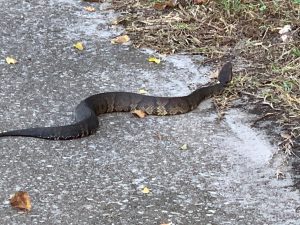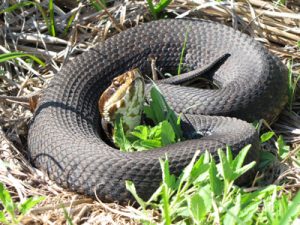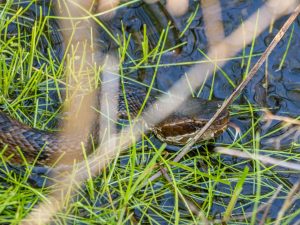I am going to end 2023 with an article on a project I hope to conduct in 2024. It will focus on insular cottonmouths and will focus on the western panhandle, though those in the eastern panhandle might be interested and could help. For obvious reasons, conducting this project as a citizen science one is not the best idea. Cottonmouths are venomous snakes and can be dangerous, but there could be opportunities where citizens could be of help (a road killed snake for example).

Photo: Bob Jackson
The story is quite interesting. Most books and articles on cottonmouths indicate they inhabit freshwater habitats where water flow is slower. Though found in the back waters of rivers, they are not as common within the rivers themselves. Golf courses, ponds, lakes, and reservoirs are other places they frequent. There are records of them on coastal barrier islands and in the upper Florida Keys. Swimming across saltwater is not surprising but existing on a xeric, sandy barrier island would not fit the typical habitat of this snake. Most of the accounts on barrier islands are in the Big Bend region and many know that there are freshwater habitats on some of these islands. If a cottonmouth could reach the island, there could be a suitable habitat for them. But you could argue that these habitats are not large enough to support a large population. The carry capacity of a population is determined by the amount of space and resources available. Cottonmouths are opportunistic feeders – so, finding food would not be a big issue – but with limited acreage of needed freshwater the carrying capacity would be lower, and populations of cottonmouths lower as well. Then there is Seahorse Key.

Image: Google Earth
Seahorse Key is 3 miles southwest of Cedar Key and can only be accessed by boat. It is said that the density of cottonmouths is higher there than anywhere in the state. Dr. Coleman Sheehy (University of Florida) stated they typically encountered 30 snakes while conducting beach walk surveys and they estimated about 600 cottonmouths on the island. The fact that cottonmouths were there was not surprising, but the high density – in a habitat not really suitable for such – was.
There is another story on addressing that issue you can read at – https://nwdistrict.ifas.ufl.edu/nat/2015/08/07/the-mystery-on-seahorse-key/.
Depending on which source you use, there are up to three subspecies of cottonmouths found in the U.S. The Florida cottonmouth (Agkistrodon piscivorous conanti) is the one found on Seahorse Key, the rest of peninsula Florida, and in the panhandle as far west as Gulf County. The eastern cottonmouth (A.p. piscivorous) is found from Bay County west to Escambia County on the Florida/Alabama line, and north into the coastal plains of Alabama and Georgia. The western cottonmouth (A.p. leucostoma) is found from the Alabama/Florida line west to Texas and north to Arkansas. Dr. Harvey Lillywhite (University of Florida), and others, were curious as to whether the Florida cottonmouth was adapting to saltwater. An interesting question and, again, how these snakes are surviving and thriving on Seahorse Key is a part of understanding this story. In recent years there has been a push to declare the Florida cottonmouth its own species – Agkistrodon conanti. The Florida Museum of Natural History’s history article1 on cottonmouths list as such. Dr. Steve Johnson’s article2 lists the snake as Agkistrodon piscivorous and leaves it there, not dividing into subspecies. Many current researchers agree with the identification of A. conanti for the Florida cottonmouth – the one found on the islands of the Big Bend – and the one of interest in whether it is adapting to saltwater environments. That brings me back to the project we are planning to begin in 2024 in the western panhandle.
Cottonmouths definitely exist on the barrier islands in Escambia County. We have two islands – Santa Rosa Island and Perdido Key. There are freshwater sources on both islands and suitable habitat for cottonmouths. The swim from the mainland to reach these islands is much shorter than for those at Seahorse Key. At Perdido Key a swim of 600 feet would allow a snake to reach the island – easy. The swim from Perdido Key to Santa Rosa Island is less than a mile (about 4000 feet) but the currents in Pensacola Pass are strong and the likelihood of a cottonmouth accessing Santa Rosa Island this way would be low. However, there are many locations along Santa Rosa Island where the swim would be no more than a mile from the mainland and some, in Okaloosa County, the trip could be made in about 800 feet. Island access is easy.
As the Escambia County Extension Agent, I handle the snake calls that come to our office – and there are a lot of them. In recent years there has been concern from some Perdido Key residents with the number of cottonmouths they are encountering. One of their questions was whether this was an unusually high encounter rate – Seahorse Key all over. Conducting surveys in their neighborhood in 2019 I encountered cottonmouths 70% of the time – all of them were juveniles or subadults. I recommended some landscape changes to deter the snakes from their yards and in 2020 the encounter rate dropped to about 40% of the surveys. However, it did not rain as much in 2020 and this could have affected the snakes as much, if not more, than the landscaping changes. The freshwater ponds in the neighborhood used by the snakes were small and ephemeral – they did not have water unless rainfall was present. So, we did another survey in 2021, it rained more, and encounters increased to 50% of the surveys. The landscaping may have helped some. In 2021 I also conducted surveys in the nearby state park and found no significant difference in snake encounters (50%) but the time of day for encounters was different and I did find adult snakes in the state park.
Note here… I get very few calls on cottonmouths from Santa Rosa Island. Rather their calls are about eastern diamondback rattlesnakes, which are not encountered as much on Perdido Key. The question we have on the table now is whether the cottonmouths found on Perdido Key are the Florida cottonmouth (A. conanti) – the one some believe may be adapting to saltwater conditions. According to Whit Gibbons and Mike Dorcas’s Snakes of the Southeast3 Escambia County Florida is the border between the eastern and the western cottonmouth. This same guide suggests that the Florida cottonmouth does not exist here.
So here is the project… which species/subspecies of cottonmouths exist on our barrier islands in the western Florida panhandle?
How do you tell them apart?
The difference between the Florida cottonmouth and the eastern/western are very minor. This makes identification in the field hard and dangerous. The Florida cottonmouth will have two distinct stripes running vertically across the front of its snout. The eastern/western cottonmouth will not have these. To determine whether these stripes exist requires getting much closer to the snake than is recommended. THIS IS A DANGEROUS SNAKE AND CLOSE ENCOUNTERS ARE NOT RECOMMENDED. However, a road killed snake can be examined using a stick at least 12” long. NOTE: SNAKES, EVEN RECENTLY KILLED, HAVE BEEN KNOWN TO BITE. DO NOT HANDLE A DEAD SNAKE UNLESS YOU ARE SURE IT IS DEAD. You may have a camera that can get a good photo of the snout FROM A SAFE DISTANCE (cottonmouths like to rest with their head tilted upwards at a good angle for such a photo).

Photo: Steve Johnson

Photo: Ricky Stackhouse.
We are planning a program on this project in early April for Escambia and Santa Rosa Counties. If you are in Okaloosa, Walton, or Bay counties and would like the program presented there – let me know.
Rick O’Connor – roc1@ufl.edu.
References
1 Florida Museum of Natural History
https://www.floridamuseum.ufl.edu/florida-snake-id/snake/florida-cottonmouth/.
2 Florida Snakes. Cottonmouth or Water Moccasin. University of Florida Department of Wildlife Ecology and Conservation. UF Wildlife – Johnson Lab. https://ufwildlife.ifas.ufl.edu/snakes/cottonmouth.shtml.
3 Gibbons, W., Dorcas, M. 2005. Snakes of the Southeast.
 4
4
